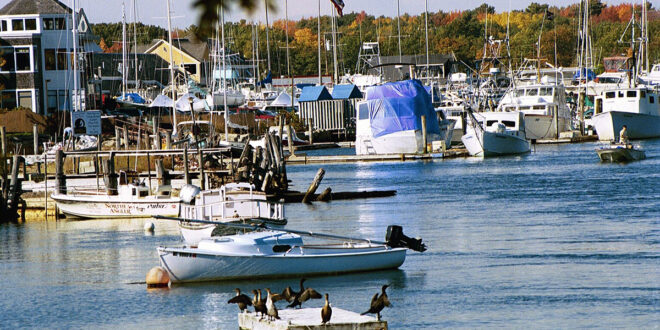Laima Vincė.
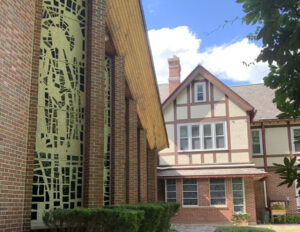
When I was growing up in the 1970’s and 1980’s, our family made a yearly summer pilgrimage to the St. Anthony’s Guest House on the Franciscan monastery grounds. My mother recalls spending her summers here in the 1950s and 1960s. Back then, we would hear Lithuanian spoken on the streets in the lower village and on Gooch’s beach. The Franciscan Monastery served as a meeting point and an oasis for Lithuanian émigrés who had escaped from Soviet-occupied Lithuania during World War II. Later, their children and grandchildren continued to visit.
Lithuania is known as “The Land of Mary” because of the Franciscan devotion to Holy Mary. Italian Catholic friar Francis of Assisi founded the order in 1209, and Franciscans adhere to his teachings and spiritual discipline. The first Franciscan monasteries appeared in Poland, neighboring Lithuania, in 1226, shortly after the death of Francis of Assisi. The first Franciscan monks came to Lithuania under the reign of King Mindaugas (1202–1263). After the Christianization of Lithuania in 1387, the first bishops of Vilnius, Andrew and Jacob, were elected from the Franciscans. Lithuanian Franciscan monks were the first propagators of Catholicism in the Grand Duchy of Lithuania. During the 18th and 19th centuries, they preached in various languages and were known for their devotion to the Immaculate Conception of the Blessed Virgin Mary; hence the Grotto of Our Lady of Lourdes (constructed in 1953) occupies a prominent place within the landscape of the monastery grounds of the Franciscan Monastery of Kennebunkport, Maine. This year the St. Anthony Franciscan Friary celebrated its 75th anniversary.
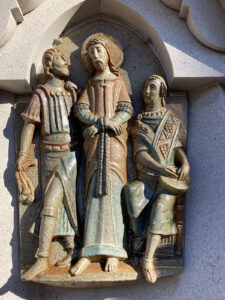 Most who fled Lithuania at the end of World War II were members of the professional and intellectual class who knew from their experience of the Soviet occupation of 1940–41 that they were targeted for deportation to Siberia by the Russians. Their immigration to the United States and Canada took place not from Lithuania directly but from the Displaced Persons (DP) camps of Germany and Austria. Historians consider this migration diasporic because it was caused by war, displacement, and political instability. Most members of this group did not consciously choose to emigrate from their country, and this circumstance left a distinct psychological and emotional mark on this group and their descendants. These emigrants fled Soviet repression and ended up in the West, not of their own will – most of them expected the Soviet occupation to be temporary and believed they would return home within a few years. Once it became apparent during the Yalta Conference that Soviet-occupied lands in northern and eastern Europe, including the Baltic Countries, would remain under Soviet Russian occupation, Lithuanian displaced persons began emigrating to the United States and Canada, determined to build a new life in the New World, but also to create cultural and religious centers where Lithuanian language and culture could flourish. St. Anthony’s Monastery in Kennebunkport was such a center.
Most who fled Lithuania at the end of World War II were members of the professional and intellectual class who knew from their experience of the Soviet occupation of 1940–41 that they were targeted for deportation to Siberia by the Russians. Their immigration to the United States and Canada took place not from Lithuania directly but from the Displaced Persons (DP) camps of Germany and Austria. Historians consider this migration diasporic because it was caused by war, displacement, and political instability. Most members of this group did not consciously choose to emigrate from their country, and this circumstance left a distinct psychological and emotional mark on this group and their descendants. These emigrants fled Soviet repression and ended up in the West, not of their own will – most of them expected the Soviet occupation to be temporary and believed they would return home within a few years. Once it became apparent during the Yalta Conference that Soviet-occupied lands in northern and eastern Europe, including the Baltic Countries, would remain under Soviet Russian occupation, Lithuanian displaced persons began emigrating to the United States and Canada, determined to build a new life in the New World, but also to create cultural and religious centers where Lithuanian language and culture could flourish. St. Anthony’s Monastery in Kennebunkport was such a center.
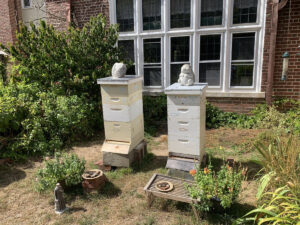
The Franciscan Monastery Estate was formerly owned by the Rogers family of Buffalo, New York. In 1890, William A. Rogers, Esq. commissioned the architectural firm of Green and Wicks to build a “splendid house in the Tudor style.” On September 8, 1947, Lithuanian Franciscans purchased the estate. This order was formerly located in Greene, Maine, and its members had emigrated from Lithuania in the early 20th century.
When Soviet Russia invaded Lithuania in 1940, Catholic priests and nuns were targeted by the Soviet regime. Communist ideology and atheism were forced upon the population. Individuals who represented any religion inside the Soviet Union were deported to hard labor camps in Siberia in June 1941 and again in the later 1940’s and 1950’s. Franciscan monks who were able to escape to the West eventually found shelter at St. Anthony’s Franciscan Monastery in Kennebunkport.
The monastery houses magnificent works of unique Lithuanian art created by major émigré Lithuanian artists of the 20th century who studied in the art academies of Paris and Vienna before World War II. This article outlines a walking tour that a visitor can take through the monastery grounds to experience the magnificent art available for anyone to enjoy.
A walking tour
To begin our tour, we will walk the path that leads through the English Park towards the sculpture of the Militant, Suffering, and Triumphant Church, featured in the Vatican Pavilion at the 1964 New York World’s Fair. This sculpture is designed by the Lithuanian émigré artist Vytautas Jonynas (1907–1997). In 1931, Jonynas traveled from his home in Lithuania to Paris, where he studied at the Conservatoire National des Arts et Metiers and Ecole Boulle. In 1937, he received two gold medals at the Paris World’s Fair; in 1938, he was awarded the rank of officer in the French Legion of Honor by the French government. As a celebrated artist and professor of art, had it not been for the rise of Nazi Germany and Soviet Russia, Jonynas would have continued on a successful career path. Soviet Russia targeted artists, writers, professors, teachers, diplomats, and government employees for extermination either by execution or in its hard labor camps in Siberia. Only those artists who collaborated with the Soviets and produced propagandistic social realist art propagating the regime survived.
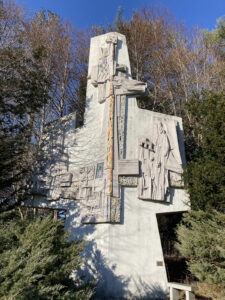
Jonynas and his family fled Soviet-occupied Lithuania in 1944 and found refuge in the French zone of the allied territories of postwar Germany. In 1946, in Freiburg, Germany, he founded the Foreign Artists’ Institute of Fine Arts, where he directed the institute and taught. Dalia Augūnas (born 1923) is one of the last living Lithuanian displaced persons who remembers the artistic and literary renaissance that took place in the DP camps where almost all interwar Lithuania’s artists, writers, musicians, and professors found themselves living together in former army barracks and other temporary housing. Just three months shy of her 100th birthday, she shared her memories of Jonynas’s art school that functioned under dire conditions in postwar Europe.
In Freiburg, the artist Vytautas K. Jonynas opened an Arts and Crafts Academy called “Ecole des Arts et des Metiers.” Students who wished to study art rushed to Freiburg to be able to study with him. After World War II, most DPs lived with the hope that they would soon return home to Lithuania and that life in Germany was only temporary. However, we received almost no news from Lithuania. People had already experienced Soviet brutality and deportations under the first Soviet occupation, so they were afraid to write to their relatives. We were afraid that contact with us would harm them. At the same time, we put enormous trust in the West.
The Lithuanian émigré graphic artist and stained-glass designer Vytautas Ignas (1924–2009) was a student of Jonynas in Freiburg. His work has a distinctive style that combines the influences of simple folk art that one sees in the countryside of Lithuania with modernist expression — a few examples of his black and white prints hang inside St. Anthony’s Chapel.
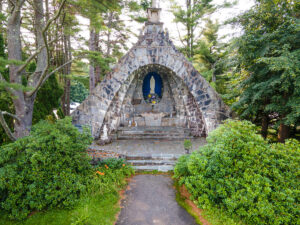
In 1952, the Tudor-style house was embellished with the Shrine of St. Anthony. In 1953, the Grotto of Our Lady of Lourdes was constructed on the estate grounds. In 1959, the Chapel of the Stations of the Cross was built. Lithuanian émigré architect Jonas Mulokas, winner of the First Prize of the American Architects Association, designed these shrines in an early 20th-century Lithuanian modernist style, echoing the major trends of European art from the 1920s and 1930s.
Viewing the Chapel of the Stations of the Cross is well worth the walk across the lawn and through the flocks of geese congregating there. The unique sculpted and hand-fired ceramic plates depicting each of the Stations of the Cross, the two ceramic angels that flank the entrance to the chapel, and the large kiln-fired ceramic Christ on the Cross, were all designed by the Lithuanian émigré sculptor, Vytautas Kašuba, known for his work with monumental figures cast in bronze. Kašuba received his early training as an artist in Lithuania and represented his country at the 1937 World’s Fair, where he won gold and silver medals for his work in wood.
It is well worth your while to examine each Station of the Cross from up close carefully. You will see how the artist uses a balance of cool blues and warm brown and orange tones to make the figures pop out of the familiar scenes of Christ’s journey to the cross. The individual faces of the figures express pain, hope, joy. Beneath each Station is a holy relic. Unfortunately, vandals have broken into most of them and have stolen their contents.
Dalia Augūnas remembers the struggles of the émigrés in their early days in America:
Life was very different for those with degrees in the Humanities, for judges, and for military personnel. They had a difficult start in America because they could not make use of their expertise in the United States. They had to start off as simple laborers. The poet Kazys Bradūnas went to work in a cemetery as a grave digger. Marius Katiliškis worked in a furniture factory. I could give many similar examples. It was easier for doctors and engineers to find their place in their new life and in a new culture. Oh, but it was not at all easy for people in the Humanities and in the Arts and everyone else.
You might wonder: who paid for all this magnificent artwork? Surely not the refugees who arrived in the United States not speaking English, with obsolete diplomas, who had to build a new life for themselves and their families from nothing? A bronze plaque dated 1958 on the opposite side of the Chapel of the Stations of the Cross provides an answer. The plaque lists the names of donors, all Lithuanian émigrés who came from the DP camps of Europe to America. While struggling to gain a foothold in America, they made it their priority to donate any extra income to creating beautiful communal environments where they could gather and celebrate their culture and language and hope to pass it on to their children.
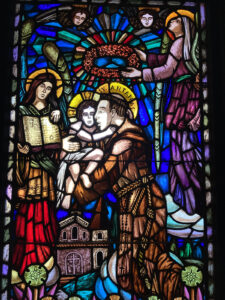
Let’s stroll back to St. Anthony’s Chapel, constructed between 1965 and 1966. When you enter the Chapel, a stained-glass window on your left depicts a Lithuanian representation of Holy Mary. The names of the saints, St. Anthony and St. George, are written in Lithuanian on the other stained-glass windows in the vestibule.
When looking at the Lithuanian crosses — either the large wooden traditional Lithuanian “roadside cross” in front of the monastery lawn or the small individual crosses inside the Chapel – note how the traditional Lithuanian crosses differ from the usual ones. Elements of the pre-Christian Lithuanian pagan religion are expressed within the cross in the symbols of the sun and the moon. They represent Saulė, the mythological sun goddess, and Mėnulis, the mythological male god of the night. While most Western civilizations identified the sun as male and the moon as female, Lithuanian mythology is the opposite. According to Lithuanian émigré archeologist Marija Gimbutas, this indicates that traditional Lithuanian folk culture was matriarchal.
Inside the chapel, note the unique method of combining cement with stained glass. Also, note how traditional saints and Catholic motifs are represented through the lens of modernist art in the stained-glass windows, but then the stained-glass doors leading into the Chapel are of an abstract design.
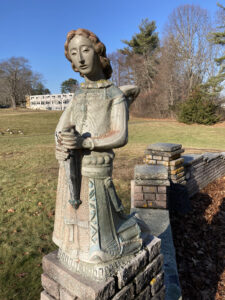 The altar and frescos behind the altar are designed using a technique of cement relief. The chapel’s architect was also a Lithuanian émigré, Dr. Alfred Kulpa of Toronto, Canada. The interior decorations, including the bas-relief, the altars, the stained-glass windows, the candle sticks, and chandeliers, were magnificently designed, produced, and arranged by Jonynas, Kašūba, and other Lithuanian artists who saw church art as a means of passing on Lithuanian religious traditions and inspirational art.
The altar and frescos behind the altar are designed using a technique of cement relief. The chapel’s architect was also a Lithuanian émigré, Dr. Alfred Kulpa of Toronto, Canada. The interior decorations, including the bas-relief, the altars, the stained-glass windows, the candle sticks, and chandeliers, were magnificently designed, produced, and arranged by Jonynas, Kašūba, and other Lithuanian artists who saw church art as a means of passing on Lithuanian religious traditions and inspirational art.
Once you leave the Chapel, stroll along the contemplative paths of the monastery park that lead down to the shores of the Atlantic. You will see white plaster sculptures and shrines. Although these works of religious art are not sculpted by the great masters described earlier in this article, they are noteworthy for their cultural value. We see important religious figures, such as St. Anthony and St. Francis, surrounded by benevolent animals and Holy Mary. At the trail’s end, you will come upon a statue of Kateri Tekakwitha (1656–1680), the first Native American woman canonized a saint.
Here you may linger to enjoy the ocean breezes wafting in or the sound of the wind rushing through the tall pines.

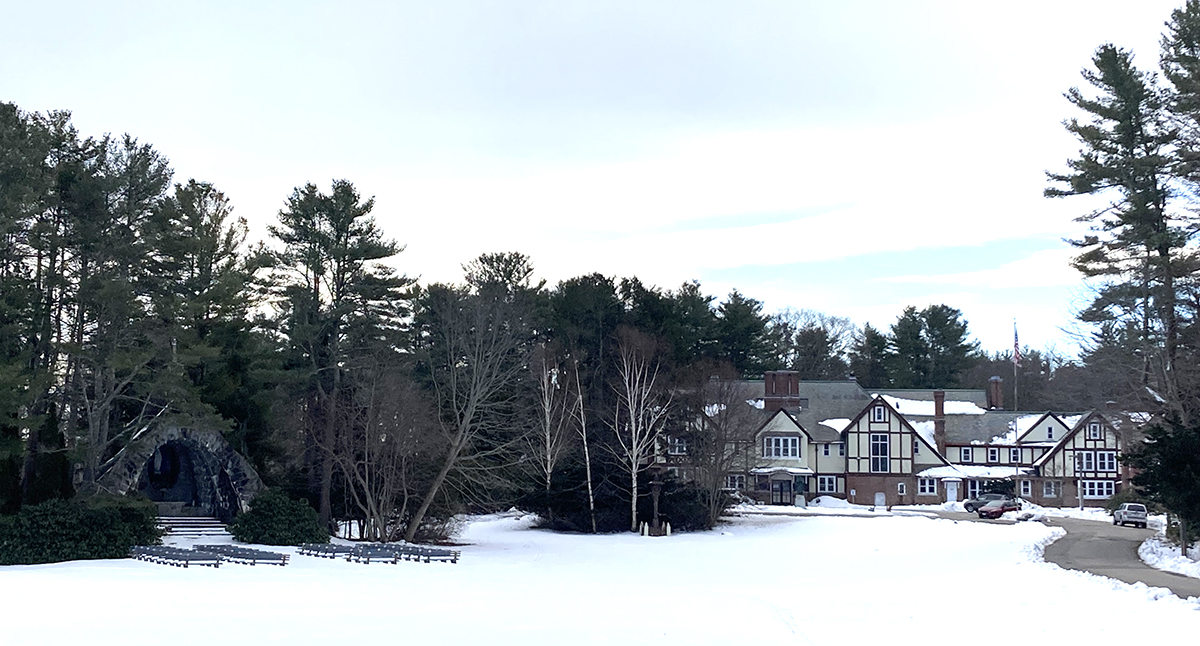
 DRAUGAS NEWS Lithuanian World Wide News in English
DRAUGAS NEWS Lithuanian World Wide News in English
